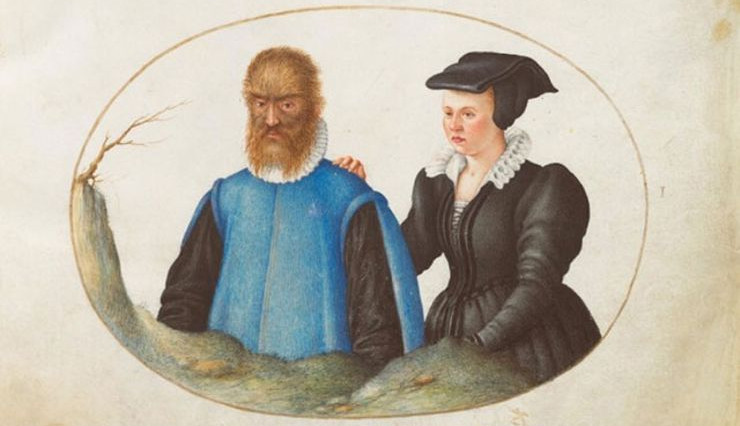Real-life and Monster version
Petrus Gonsalvus, the monster-shaped man with fur covering his body, lived happily for 45 years next to his beautiful wife.
French writer Gabrielle-Suzanne de Villeneuve wrote the story of Beauty and the 1740 Monster based on the true story of Petrus Gonsalvus and the girl named Catherine, according to Mirror.
Petrus's real name is Pedro Gonzalez , born in 1537 in Tenerife, an island in Spain. His face and body were covered in thick thick hair that made him look like a werewolf in legend.
Pedro suffers from a hairy genetic syndrome or Ambras syndrome , stimulating hair that grows throughout his body. This rare gene mutation is also called "werewolf syndrome" and only 50 cases have been recorded since the Middle Ages, in which Pedro was the first.
There is very little information about Pedro's family, however, his appearance makes his contemporaries fear and re-admire. When Pedro was 10 years old, he was taken to France as a gift to King Henry II and Queen Catherine de Medici.
When he appeared, the doctors and scholars in the royal court poked and tickled him to see if he roared. However, he surprised them by whispering his name. He was locked in a dungeon for other tests.

Pictures of Petrus Gonsalvus and his wife Catherine.(Photo: National Museum of Art).
When scholars report that Pedro is still a child and does not appear aggressive or use magic, King Henry decides to conduct an experiment. Pedro is allowed to retain his name but in Latin as Petrus Gonsalvus. He was dressed in beautiful clothes and enjoyed an education for noble boys. King Henry wanted to know if he could turn a wild boy into a gentleman.
After showing his ability to learn quickly with the fluency of three foreign languages, Petrus lived under the protection of the king, often appearing to receive guests and foreign nobles. In 1955, the king was killed in a jousting competition. Empress Catherine took over Petrus and decided to continue the experiment by giving Petrus marriage and childbirth in 1573. She began looking for the bride and wanted a woman who was strong enough to overcome the shock of meeting. Petrus at the ceremony, just beautiful enough to awaken the instinct in his being.
The girl named Catherine, the queen chose to be the daughter of an unknown servant of their name. Petrus and Catherine spent the wedding night under the watch of the queen's doctors, who were excited to observe how the monster man's paired up and wanted to see if the beautiful girl could survive. .
Petrus couple have a happy marriage life, surprising many people. Catherine gave birth to two sons, Paolo and Ercole, who were not inherited from her father's illness, but her two sons Enrico and Orazio became ill. They also had three daughters, Maddalena, Francesca and Antoinetta, all of whom had hairs.
The Petrus family attracted international attention and was allowed to travel within Europe to stay with other nobles. They settled in Spain under the patronage of Duke Parma. Duke Parma allowed Petrus to use a mansion near Parma but had to bring sick children to other dukes as a gift.
Petrus and his wife spent the last years of peaceful life in a Bolsena lake mansion in Capodimonte, Italy. They were treated with respect as ordinary citizens and Petrus even attended the baptism of his grandson in 1617. He died a year later at the age of 81, and Catherine's wife died in 1623.
However, Petrus's life story does not end like a fairy tale. When he died, Petrus did not anoint the forehead with oil in the final rite. That means he cannot be buried in the cemetery and eventually, Petrus is still seen as an animal.
- Seeing the scowl is seen as a real-life Angry Bird version
- Real life 'King Kong' monster has become extinct for this reason
- Research can prove real Loch Ness monsters are real
- Kraken monster is real?
- What is 'monster larva' actually?
- 10 most famous aquatic monsters of all time
- Is the 'Pirate Island' real-life version disappointing One Piece fans?
- Discovering 'super ice monster' destroying alien life
- German Museum shows off White Snow tombs 'real version'
- Mysterious skinhead monster in Japanese legend
- Loch Ness monster monster objects head up on the lake
- The most convincing picture of the Loch Ness monster
 'Fine laughs' - Scary and painful torture in ancient times
'Fine laughs' - Scary and painful torture in ancient times The sequence of numbers 142857 of the Egyptian pyramids is known as the strangest number in the world - Why?
The sequence of numbers 142857 of the Egyptian pyramids is known as the strangest number in the world - Why? History of the iron
History of the iron What is alum?
What is alum?